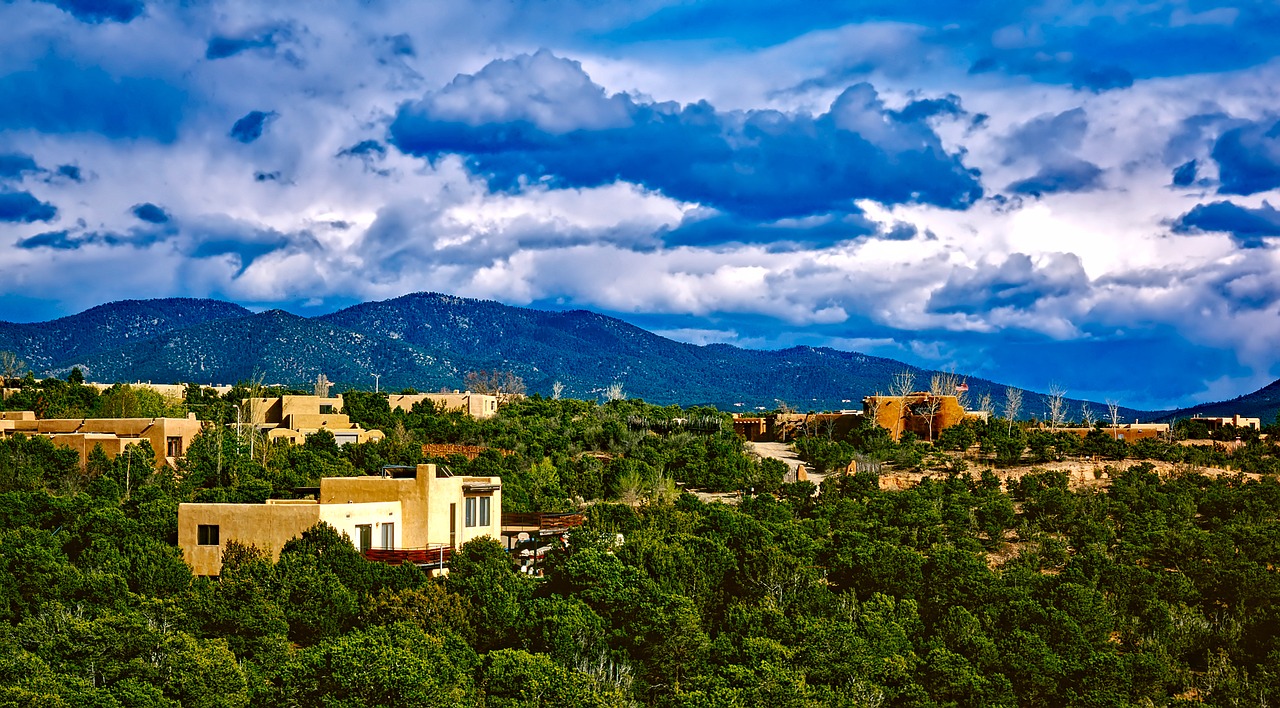
Article Summary: National Parks Near Santa Fe
National Parks near Santa Fe! There’s so much more to Santa Fe than the Georgia O’Keeffe Museum and the Santa Fe Opera House.
In this article, we’ll familiarize you with the incredible national parks that are within a day’s drive of downtown Santa Fe.
There are 10 national park sites for you to see on your next visit to the Land of Enchantment.
Santa Fe, New Mexico is a majestic and quirky city in the so-called “Land of Enchantment” that is famous for, among other things, its rugged desert beauty, the area’s robust artistic legacy, stellar intersectional culture, and lovely, multiethnic, Southwestern-style food.
But it also has some amazing national parks within a day’s driving distance.
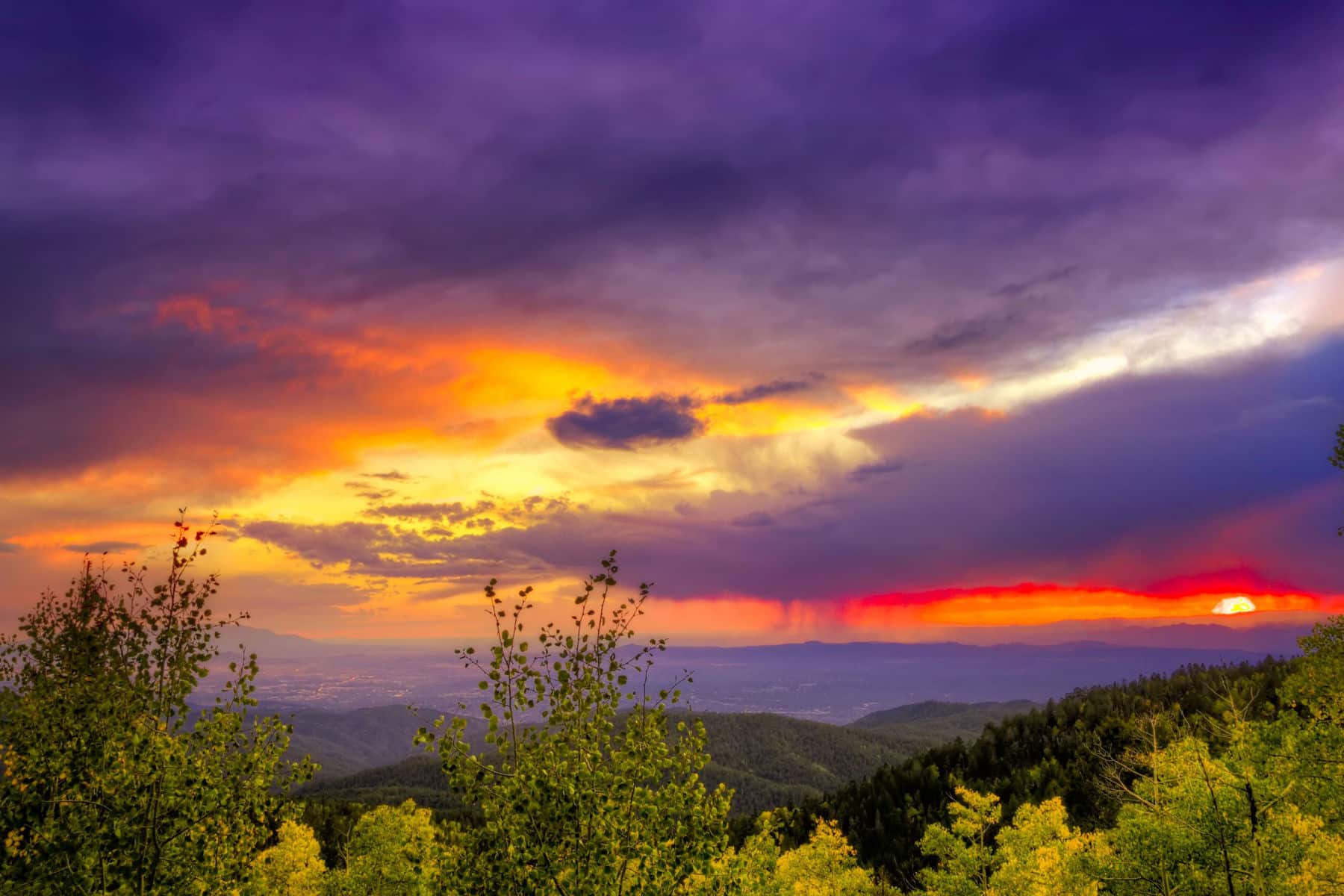
So, What Is A National Park?
We get asked that question a lot because there’s a difference between a “national park” and a “national park site.” To help you understand that difference you might want to check out our article titled: What Is A National Park Really?
If you’re planning a trip to the Santa Fe area then one book that I highly recommend is: The Streets of Santa Fe: A Walking Tour from 1880 to the Present by Josh Gonze.
Now let’s go ahead with 10 reasons why you’ll want to hop in your car and make a day’s drive from Santa Fe to one of these truly amazing places.
Table Of Contents: National Parks Near Santa Fe
National Parks Near Santa Fe
1. Aztec Ruins National Monument
Distance From Santa Fe: Three hours and 13 minutes (207 miles) via US-550 N.
I taught World History for almost 30 years. One of my favorite topics of study was the civilizations of pre-Columbian America. Foremost among these civilizations were the Aztecs, who probably originated as a nomadic tribe in northern Mexico, around the beginning of the 13th century.
Aztec Ruins National Monument is situated in the town of Aztec, and covers an area of about 319 acres. The site was designated a national monument by President William Howard Taft in 1923, and was added to the National Register of Historic Places in 1966.
The monument preserves the remains of an ancestral Puebloan community that flourished in the area from about the 11th to the 13th centuries. The ruins are well-preserved, and include a great kiva, multiple smaller kivas, and a variety of rooms and structures. The buildings are constructed of sandstone, and are decorated with intricate patterns and designs.
The Great Kiva
One of the most impressive features of the site is the Great Kiva, which is a circular ceremonial chamber that measures about 41 feet in diameter. It was likely used for religious and community gatherings. Other notable structures at the site include a series of interconnected rooms known as West Ruin, and the reconstructed Aztec West Great House.
Visitors to the Aztec Ruins National Monument can take a self-guided tour through the site, and can learn about the history and culture of the ancestral Puebloan people through interpretive exhibits and displays.
The monument also offers a variety of educational programs and events throughout the year, including guided tours, ranger-led talks, and cultural demonstrations.

RELATED: These 24 EPIC Arizona National Parks Will Blow Your Mind
2. Bandelier National Monument
Distance From Santa Fe: Located about 40 miles (47 minutes) northwest of Santa Fe proper (via US-84 W & NM-4 W), the Bandelier National Monument is open every day from dawn to dusk.
Bandelier National Monument was established in 1916 to protect and preserve the archaeological sites and structures of the Ancestral Puebloan people who lived there over 800 years ago.
The monument features a unique combination of natural and cultural resources, including rock cliffs, cave dwellings, and kivas (underground ceremonial rooms).
Visitors can explore the park’s trails, which offer views of the ancient petroglyphs and pictographs on the cliffs and in the caves, as well as the partially restored pueblo structures.
The history of Bandelier National Monument reflects the complex social and cultural evolution of the ancestral Pueblo people, who lived in the region until the late 1300s, and highlights the importance of preserving and interpreting the rich cultural heritage of the Southwest.
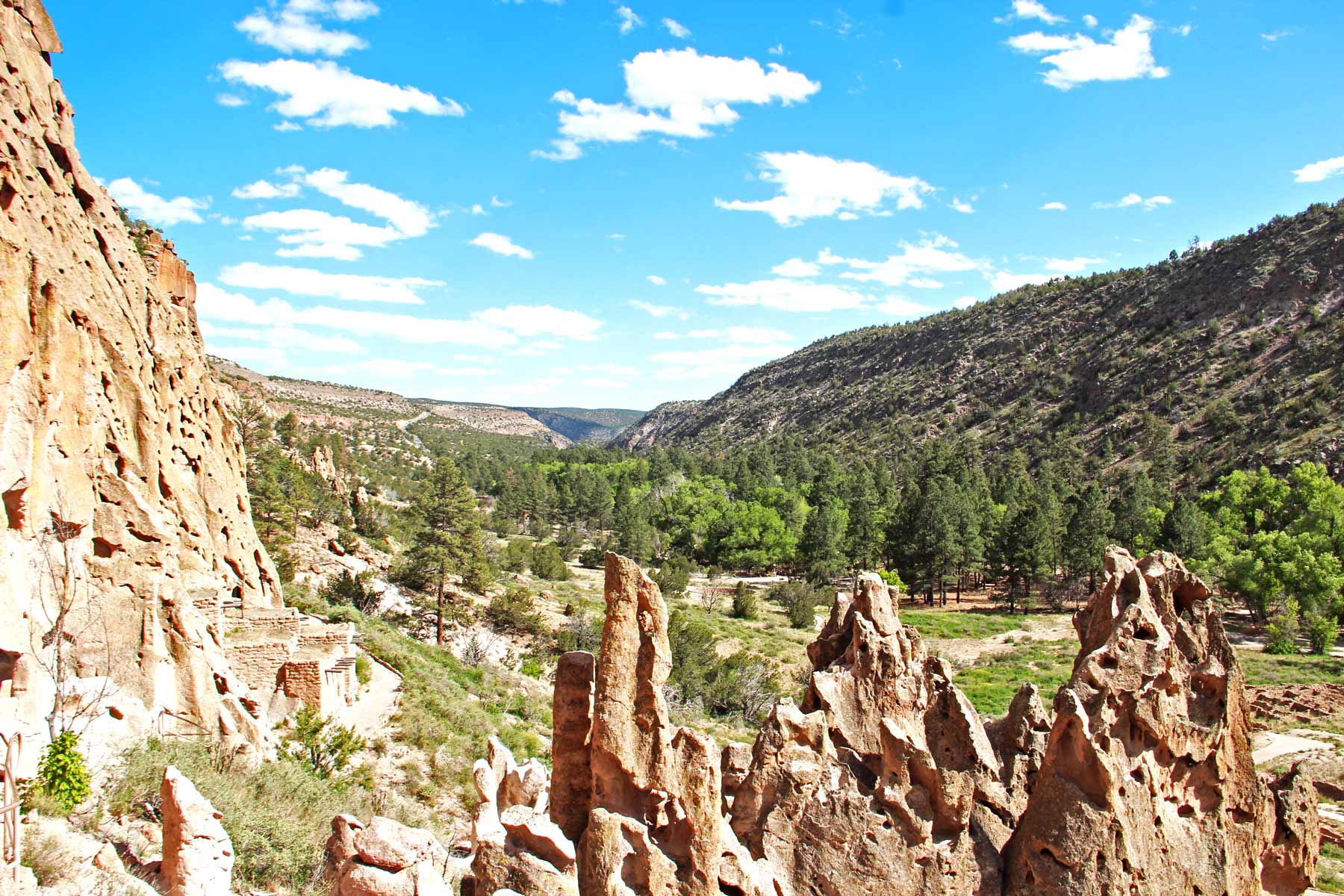
To learn more I recommend: Bandelier National Monument: Home of the Ancestral Pueblo People
3. Carlsbad Caverns National Park
Distance From Santa Fe: Four hours and 32 minutes (293 miles) via US Hwy 285 S.
Carlsbad Caverns National Park was established in 1930 to protect and preserve the over 100 known caves in the area, including the iconic Carlsbad Cavern.
The caves formed over 250 million years ago as sulfuric acid dissolved the surrounding limestone, creating a network of underground chambers and passages. For thousands of years, the caves were used by Native American tribes for religious and cultural purposes.
In the late 1800s, the caves were discovered by European settlers and eventually became a popular tourist destination.
Today, Carlsbad Caverns National Park attracts visitors from around the world, offering guided tours, self-guided walks, and ranger-led programs to explore and learn about the fascinating geology and history of the caves.

RELATED: 10 AMAZING Facts About Carlsbad Caverns National Park
Things To Do At Carlsbad Caverns
Carlsbad Caverns National Park offers a variety of activities for visitors to enjoy:
- Cave Tours: Guided and self-guided tours of the caves, including the famous Big Room, offering a unique and awe-inspiring underground experience.
- Bat Flight Program: A nightly program where visitors can observe the exit of hundreds of thousands of bats from the cave’s entrance.
- Hiking: Miles of hiking trails through the Chihuahuan Desert, offering scenic views of the surrounding landscape.
- Ranger Programs: Educational programs and talks led by park rangers, covering topics such as geology, history, and wildlife.
- Cave Art: Viewing of the prehistoric paintings and carvings made by the Native American tribes who used the caves for religious and cultural purposes.
- Wildlife Watching: Opportunities to observe the diverse wildlife in the park, including bats, desert reptiles, and birds.
- Camping: Campsites are available for visitors who wish to spend more time exploring the park and its surroundings.
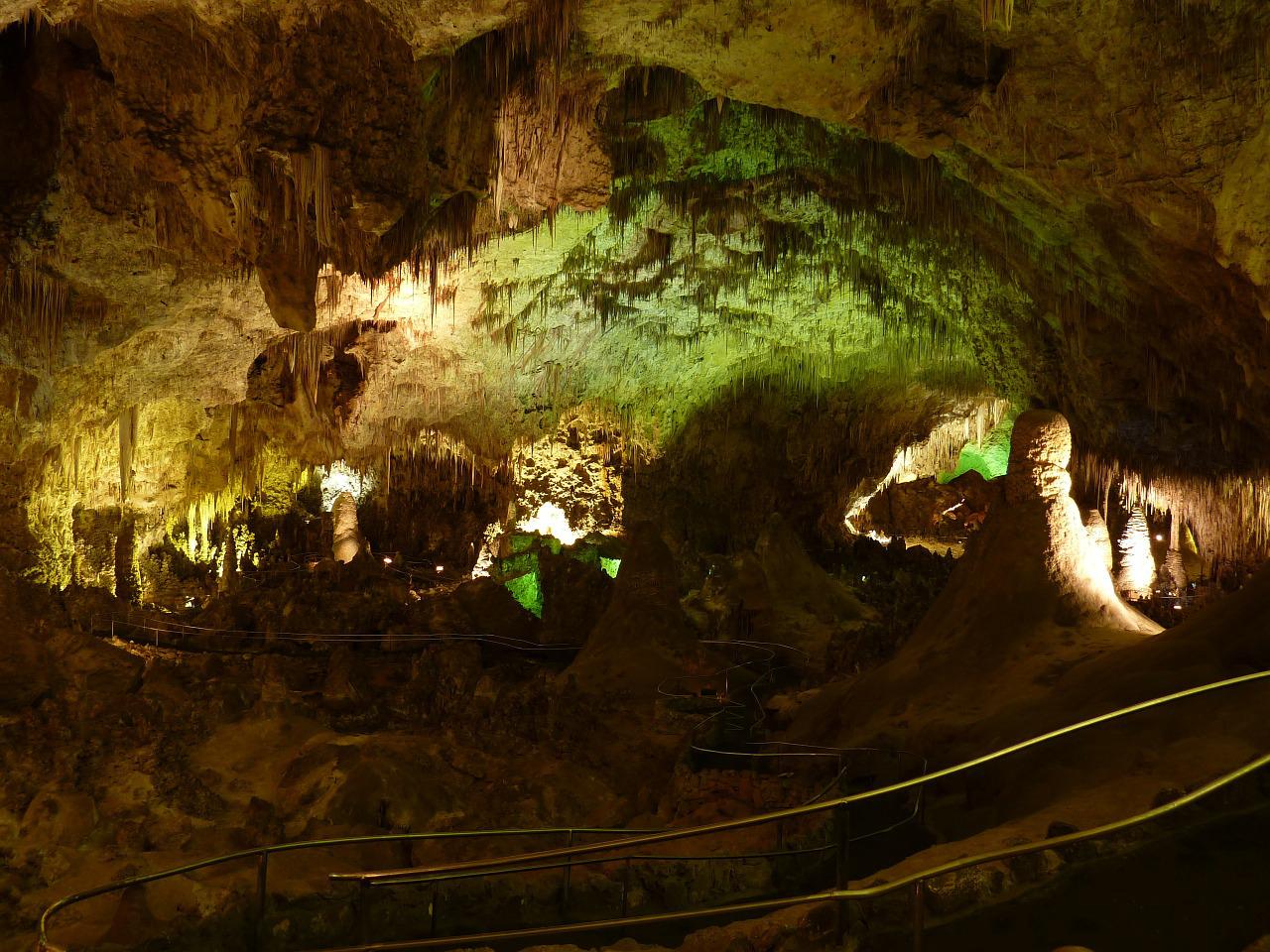
4. Chaco Culture National Historical Park
Distance From Santa Fe: Three hours (179 miles) via US-550 N.
Chaco Culture National Historical Park was established in 1980 to preserve the archaeological and cultural sites of the ancient Chacoan people, who lived in the region between 850 and 1250 AD.
The Chacoans built a remarkable complex of large, multistory buildings, roads, and great kivas, forming one of the largest and most sophisticated pre-Columbian cultural centers in North America.
The park contains a number of well-preserved Chacoan ruins, including the massive Pueblo Bonito, which was once the largest building in North America and the center of Chacoan life. Visitors can explore the ruins on foot, via ranger-led tours, or by hiking the park’s trails, which offer views of the ancient structures and the surrounding landscape.
The history of Chaco Culture National Historical Park reflects the rich cultural and architectural heritage of the Chacoan people and provides insight into the social, economic, and political organization of one of the most advanced ancient civilizations in the Southwest.

RELATED: 7 AMAZING Nevada National Parks To Visit
5. Gila Cliff Dwellings National Monument
Distance From Santa Fe: Five hours and 44 minutes (321 miles) via I-25 S.
Gila Cliff Dwellings National Monument was established in 1907 to protect and preserve the well-preserved cliff dwellings of the Mogollon people, who lived in the Gila Wilderness from the late 1200s to the early 1300s.
The Mogollon people built their homes in the cliffs, taking advantage of the natural rock overhangs for protection from the elements.
The park features several well-preserved cliff dwellings, including the Middle Mogollon complex, which contains five rooms and two kivas (underground ceremonial rooms). Visitors can explore the cliff dwellings on a self-guided tour and learn about the history and culture of the Mogollon people through interpretive displays and ranger-led programs.
The history of Gila Cliff Dwellings National Monument highlights the ingenuity and resourcefulness of the Mogollon people and provides a glimpse into the daily lives of one of the ancient cultures of the Southwest.
More National Parks Near Santa Fe
6. Manhattan Project National Historical Park
Distance From Santa Fe: Thirty eight minutes (34 miles) via US-84 W & MN-502.
The Manhattan Project National Historical Park is located at three sites in the United States: Oak Ridge, Tennessee; Hanford, Washington; and Los Alamos, New Mexico.
The park was established in 2015 to commemorate and interpret the history of the Manhattan Project, the top-secret effort during World War II to develop the first atomic bombs.
The three park sites each played a critical role in the Manhattan Project. Oak Ridge was the site of the production of enriched uranium for the bomb. Hanford was the site of the production of plutonium for the bomb. And Los Alamos was the location of the scientific research and development of the bomb.
Visitors to the park can tour the historic facilities and learn about the history of the Manhattan Project through guided tours, ranger-led programs, and interactive exhibits. The park provides a unique opportunity to learn about one of the most significant events in 20th-century history and the impact it had on the world.
The history of the Manhattan Project National Historical Park reflects the complex and challenging events of the mid-20th century, including the development of atomic weapons and the end of World War II.
The park serves as a reminder of the important role that science and technology played in shaping the world during this time and the ongoing responsibility to ensure that such powerful technologies are used for peaceful purposes.

7. Petroglyph National Monument
Distance From Santa Fe: One hour and 2 minutes (65 miles) via I-25 S.
Petroglyph National Monument was established in 1990 to protect and preserve the extensive petroglyphs (rock carvings) created by Native American and Spanish settlers in the region.
The petroglyphs at Petroglyph National Monument are among the largest and most diverse collections in North America and provide a window into the cultural and spiritual beliefs of the ancient peoples who lived in the area.
The petroglyphs at the park are thought to have been created between 400 and 700 years ago and depict a wide range of subjects, including animals, humans, and abstract designs.
Visitors to the park can explore the petroglyphs on a self-guided tour and learn about the cultural and historical significance of these remarkable artifacts through ranger-led programs and interpretive displays.
The history of Petroglyph National Monument reflects the rich cultural heritage of the Southwest and the ongoing efforts to preserve and protect the region’s important archaeological and historical sites.

RELATED: 10 EPIC National Parks Near Albuquerque You’ll Love
8. Santa Fe National Historical Trail
Distance From Santa Fe: The trail ends in Santa Fe, New Mexico.
The Santa Fe National Historic Trail stretches across Missouri, Kansas, Colorado, and New Mexico. The trail was established in 1987 to commemorate the important commercial and military route that connected Santa Fe, New Mexico, to Missouri in the 19th century.
The Santa Fe Trail was used by traders, trappers, and settlers to transport goods, such as furs and textiles, between Santa Fe and the Missouri River. The trail was also used by the U.S. military during the Mexican-American War and was a key factor in the development of the American West.
Visitors to the Santa Fe National Historic Trail can explore the trail by hiking, horseback riding, or driving, and learn about the history of the trail and the people who used it through interpretive displays and ranger-led programs.
The trail provides an opportunity to experience the scenic beauty of the American West and to understand the important role that the Santa Fe Trail played in the development of the region.

RELATED: 45 Best National Parks Books (Great Gifts For Park Lovers)
9. Valles Caldera National Preserve
Distance From Santa Fe: One hour and 39 minutes (61 miles) via US-84 W.
There is history and then there is history. About 1.25 million years ago, a spectacular volcanic eruption created the 13-mile wide circular depression now known as the Valles Caldera. Today it is much more than its geologic past however.
Valles Caldera National Preserve is known for its huge mountain meadows, abundant wildlife, and meandering streams. Valles Caldera preserves the homeland of ancestral native peoples and embraces a rich ranching history.
There are some wonderful outdoor activities offered at the preserve. They include:
- Astronomy: Whether a beginner or an expert astronomer you can view some of the darkest skies in northern New Mexico.
- Backcountry Access: Visitors can access the backcountry by foot, mountain bike, horseback, or personal vehicle.
- Hiking: The preserve includes a range of trails from easy (.5 miles) to difficult (almost 20 miles) hikes.
- Fishing: The waters of Valles Caldera National Preserve provide some great fly fishing for beginners and experts.
- Horseback Riding: You must have a permit.
- Hunting: This can be done in accordance with applicable Federal and State law.
- Mountain Biking: A backcountry permit is required.
- Wildlife Viewing: Popular residents include Gunnison prairie dogs, coyotes, badgers, black bears, Eastern mountain bluebirds, and golden eagles. (Source NPS)
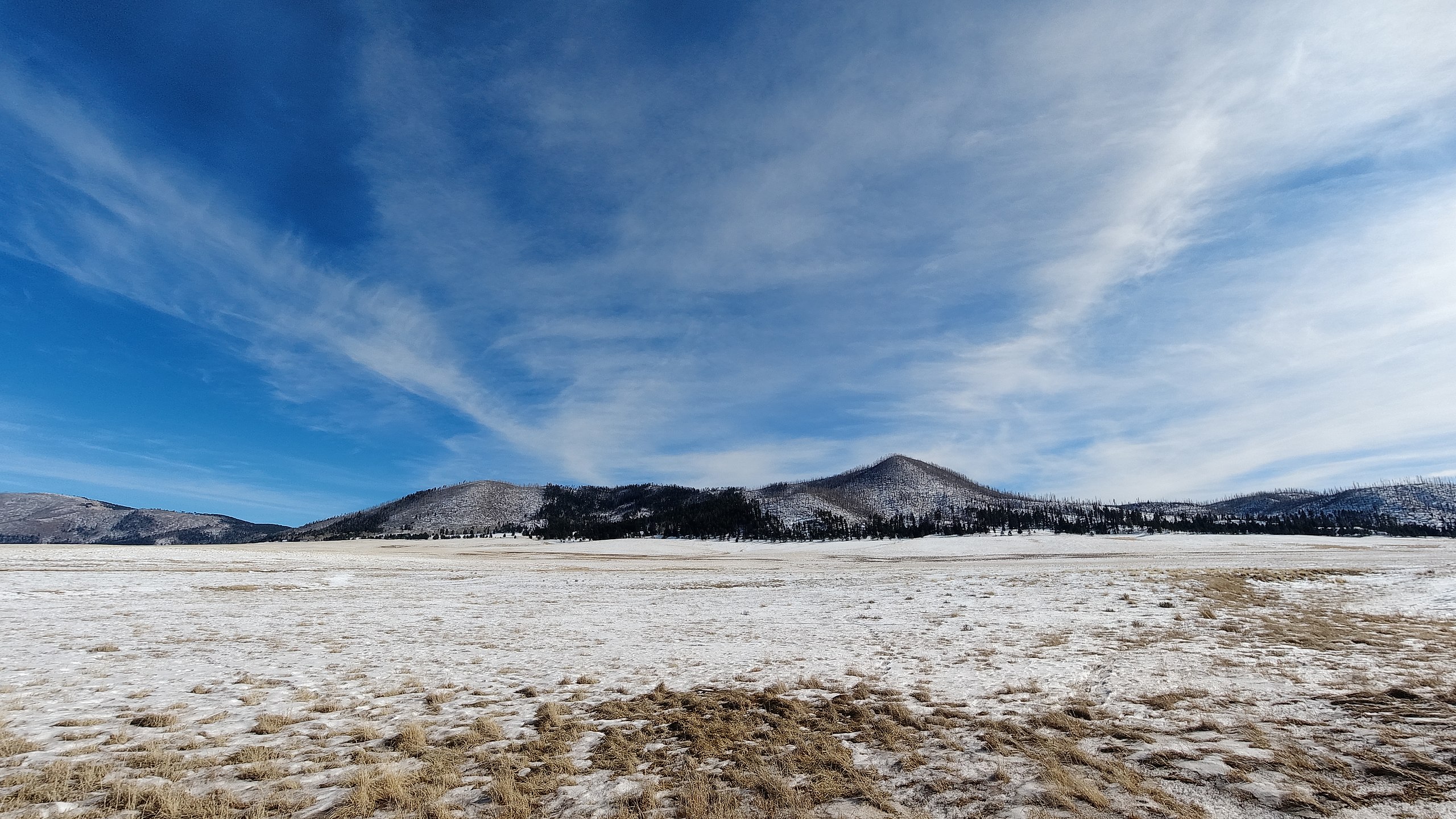
10. White Sands National Park
Distance From Santa Fe: Three hours and 41 minutes (233 miles) via US HWY-285 S & US-54 W.
White Sands National Park covers an area of approximately 145,000 acres, and is known for its iconic white gypsum sand dunes. The park was established in 1933 as a national monument, and was later designated a national park in 2019.
The dunes at White Sands are some of the largest gypsum dunes in the world, and cover an area of about 275 square miles. The sand is extremely fine and white, creating a stunning and otherworldly landscape that is popular with photographers and visitors from around the world.
The dunes are formed by the accumulation of gypsum crystals that have been blown in by the wind, and the shape of the dunes is constantly changing due to the winds that blow across the park.

Things To Do
Here are some popular activities that visitors can enjoy:
- Sledding: One of the most popular activities at White Sands is sledding down the dunes. Visitors can rent plastic sleds from the park’s gift shop and slide down the soft gypsum sand.
- Hiking: The park offers several hiking trails of varying lengths and difficulties. The Alkali Flat Trail is a 5-mile round-trip hike that takes visitors through the heart of the dune field, while the Interdune Boardwalk Trail is an easy half-mile loop that provides great views of the dunes.
- Backcountry Camping: The park offers backcountry camping for visitors who want to spend the night under the stars. Campsites are available on a first-come, first-served basis, and permits can be obtained at the visitor center.
- Stargazing: White Sands National Park is designated as an International Dark Sky Park, which means that the night skies are exceptionally dark and free of light pollution. Visitors can enjoy stargazing and night photography at several locations throughout the park.
- Ranger Programs: The park offers a variety of ranger-led programs that cover topics such as the geology of the dunes, the plants and animals that live in the area, and the park’s history. These programs are free and open to the public.
- Picnicking: The park has several picnic areas that are equipped with tables, grills, and restrooms. These areas provide a great place to relax and enjoy a meal while taking in the beautiful scenery.
- Photography: White Sands is a popular destination for photographers, and the park offers several great locations for capturing stunning images of the dunes and the surrounding landscape.
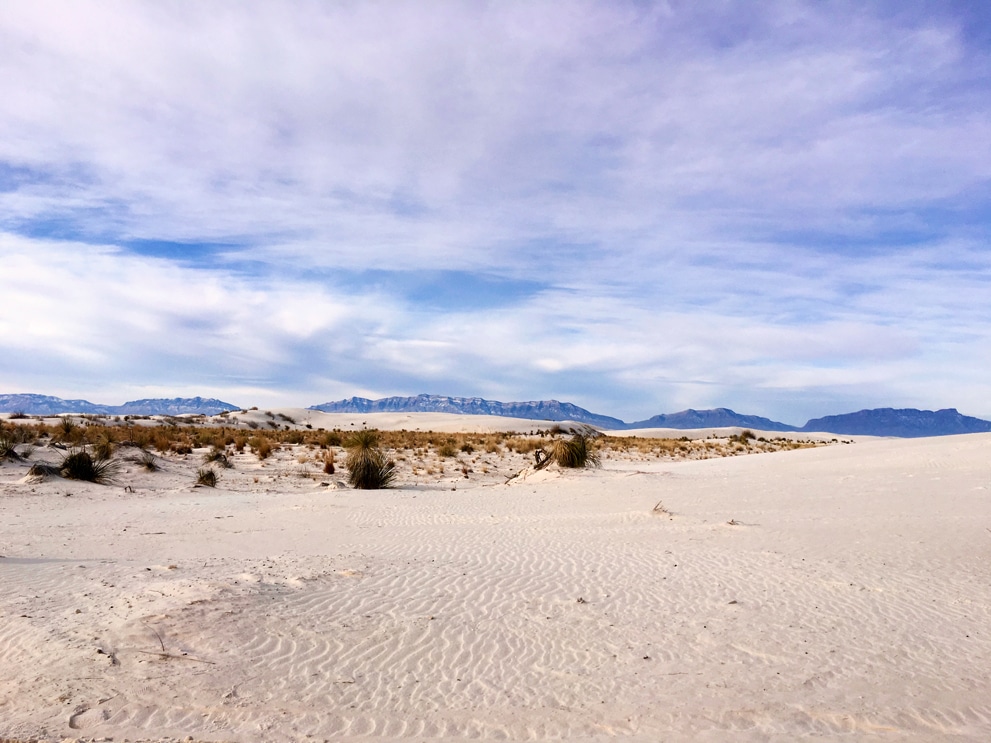
National Parks Near Santa Fe FAQ
Aztec Ruins National Monument. Distance From Santa Fe: Three hours and 13 minutes (207 miles) via US-550 N.
New Mexico has two national parks (Carlsbad Caverns, White Sands), two national historical parks (Chaco Culture, Pecos), one national heritage area (Northern Rio Grande) and 11 national monuments, including four administered by the Bureau of Land Management (BLM).
Santa Fe. As the state’s capital, Santa Fe reigns as one of the most historic, beautiful, and nicest towns in New Mexico. From the moment you arrive, you’ll be greeted by awe-inspiring adobe architecture, friendly locals, and a spectacular backdrop of the Sangre de Cristo Mountains.
Why Trust Us About National Parks Near Santa Fe?
We’re Jim Pattiz and Will Pattiz, collectively known as the Pattiz Brothers (and sometimes the Parks Brothers) and we absolutely LOVE the national parks.
You should probably know that we don’t just make this stuff up out of thin air. We’ve spent our entire adult lives exploring and filming America’s national parks and public lands.
We’ve worked with the National Park Service, the Department of Interior, USDA, and the U.S. Forest Service for years creating films on important places and issues. Our work has been featured in leading publications all over the world and even some people outside of our immediate family call us experts on the national parks.

Meet The Parks Brothers
Map Of National Parks Near Santa Fe
List Of National Park Sites Near Santa Fe
- Aztec Ruins National Monument
- Bandelier National Monument
- Carlsbad Caverns National Park
- Chaco Culture National Historical Park
- Gila Cliff Dwellings National Monument
- Manhattan Project National Historical Park
- Petroglyph National Monument
- Santa Fe National Historic Trail
- Valles Caldera National Preserve
- White Sands National Park
We Hope You’ll Follow Our Journey

Our goal here at More Than Just Parks is to share the beauty of America’s national parks and public lands through stunning short films in an effort to get Americans and the world to see the true value in land conservation.
We hope you’ll follow our journey through the parks and help us to keep them the incredible places that they are. If you’re interested in joining the adventure then please sign up below!
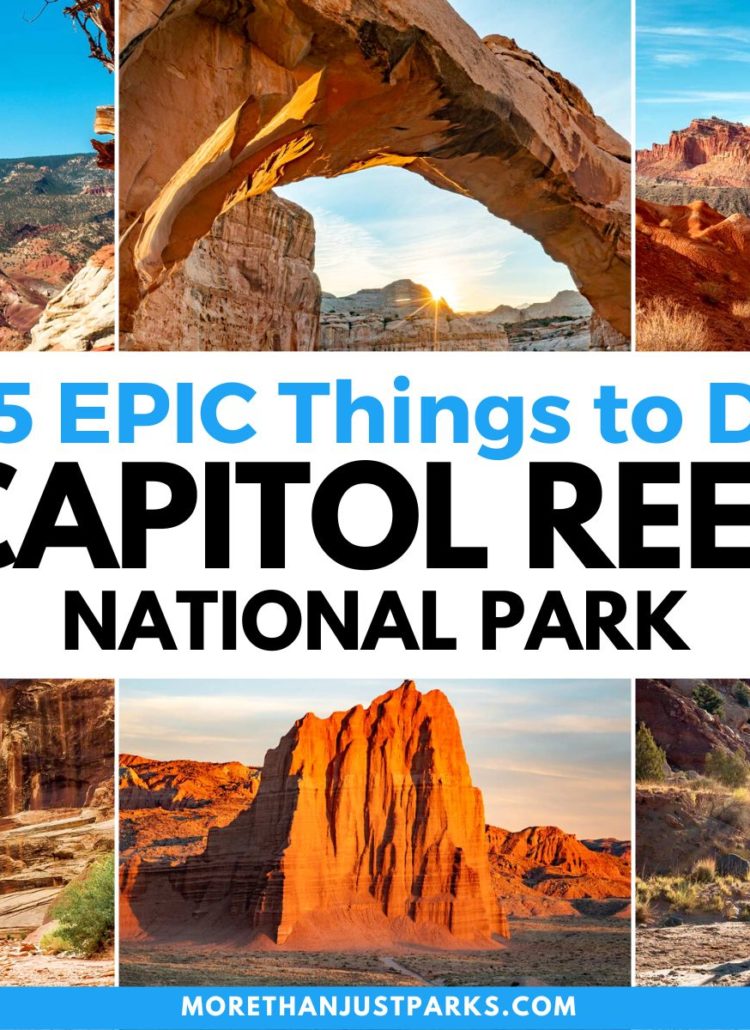
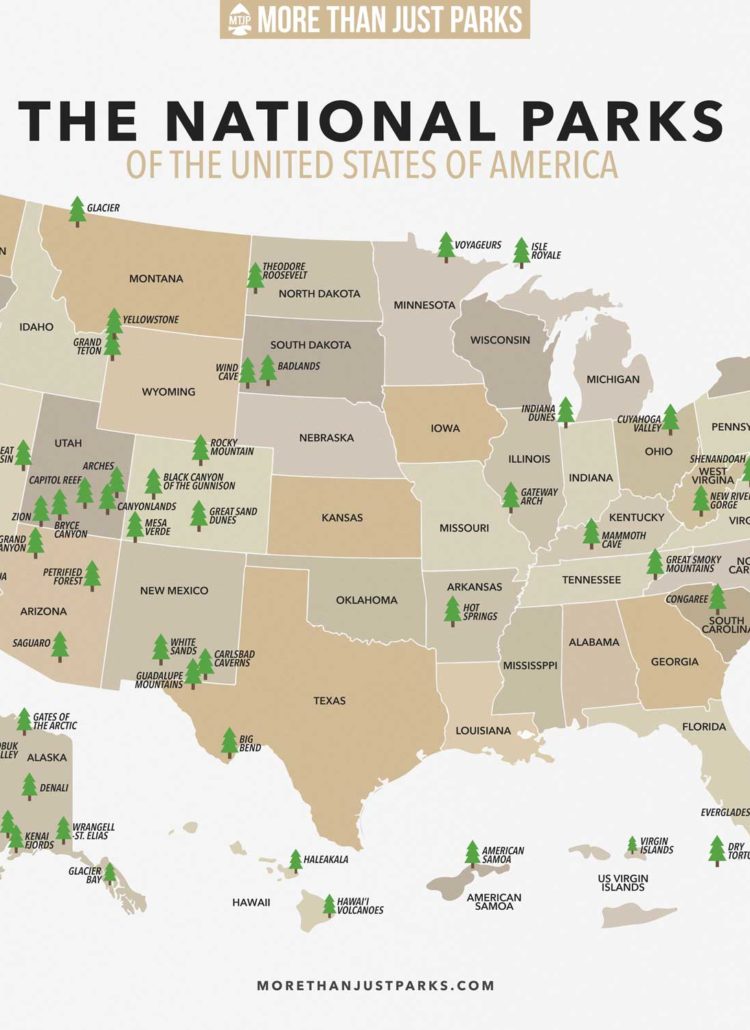



Leave a Reply